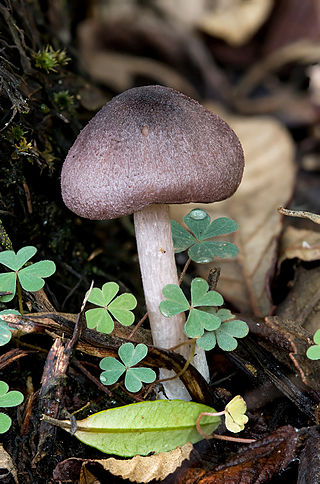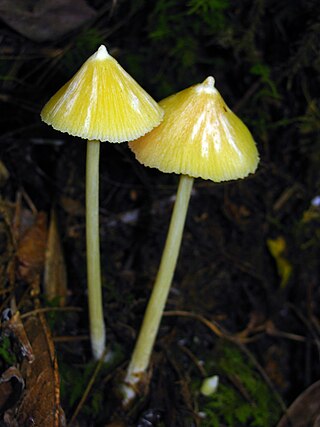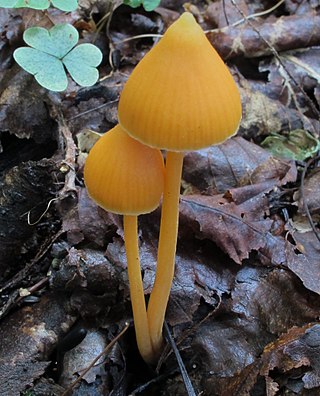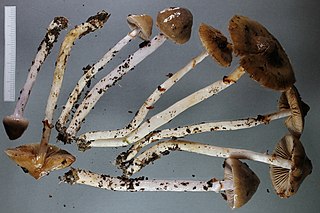
Entoloma sinuatum is a poisonous mushroom found across Europe and North America. Some guidebooks refer to it by its older scientific names of Entoloma lividum or Rhodophyllus sinuatus. The largest mushroom of the genus of pink-spored fungi known as Entoloma, it is also the type species. Appearing in late summer and autumn, fruit bodies are found in deciduous woodlands on clay or chalky soils, or nearby parklands, sometimes in the form of fairy rings. Solid in shape, they resemble members of the genus Tricholoma. The ivory to light grey-brown cap is up to 20 cm (7.9 in) across with a margin that is rolled inward. The sinuate gills are pale and often yellowish, becoming pink as the spores develop. The thick whitish stem has no ring.

Entoloma is a genus of fungi in the order Agaricales. Called pinkgills in English, basidiocarps are typically agaricoid, though a minority are gasteroid. All have salmon-pink basidiospores which colour the gills at maturity and are angular (polyhedral) under a microscope. The genus is large, with almost 2000 species worldwide. Most species are saprotrophic, but some are ectomycorrhizal, and a few are parasitic on other fungi. The type, Entoloma sinuatum, is one of several Entoloma species that are poisonous, typically causing mild to severe gastrointestinal illness.

The Entolomataceae are a family of fungi in the order Agaricales. The family contains eight genera and 2250 species, the majority of which are in Entoloma. Basidiocarps are typically agaricoid, but a minority are cyphelloid. secotioid, or gasteroid. All produce pink basidiospores that are variously angular (polyhedral), ridged, or nodulose. Species are mostly saprotrophic, though a few are parasitic on other fungi. The family occurs worldwide.

Rhodocybe is a genus of fungi in the family Entolomataceae. Basidiocarps are agaricoid producing pink basidiospores that are unevenly roughened or pustular under the microscope. Species are saprotrophic and mostly grow on the ground, occasionally on wood. The genus is distributed worldwide.

Psilocybe weraroa, formerly Weraroa novae-zelandiae, is a secotioid fungus in the family Hymenogastraceae. It is endemic to New Zealand, where it grows in native forests from rotting wood and woody debris. Despite its pouch-like form this species is closely related to Psilocybe cyanescens and Psilocybe subaeruginosa. As a bluing member of the genus Psilocybe it contains the psychoactive compounds psilocin and psilocybin. It has been cultivated commercially by Rua Bioscience with a view to researching potential medical applications, bringing together its traditional uses in Rongoā Māori with the recent interest in Western medicine into the medical applications of psilocin and psilocybin.

Cortinarius archeri is a species of mushroom in the genus Cortinarius native to Australia. The distinctive mushrooms have bright purple caps that glisten with slime, and appear in autumn in eucalypt forests.

Entoloma rodwayi, known as the green stem pinkgill, is a species of fungus in the Entolomataceae family of mushrooms. A yellowish green mushroom with pink gills and spores, it is found in wet forests of Tasmania.

Entoloma austroprunicolor is a species of agaric fungus in the family Entolomataceae. Described as new to science in 2007, it is found in Tasmania, where it fruits on the ground of wet sclerophyll forests in late spring to early winter. The fruit bodies (mushrooms) have reddish-purple caps measuring up to 5 cm (2.0 in) in diameter supported by whitish stipes measuring 3–7.5 cm (1.2–3.0 in) long by 0.2–0.6 cm (0.1–0.2 in) thick. On the cap underside, the crowded gills are initially white before turning pink as the spores mature.

Amanita australis is a species of fungus in the family Amanitaceae. It produces small- to medium-sized fruit bodies, with brown caps up to 9 centimetres in diameter covered with pyramidal warts. The gills on the underside of the cap are white, closely crowded together, and free from attachment to the stem. The stem, up to 9 cm long, has a ring and a bulbous base. The mushroom may be confused with another endemic New Zealand species, A. nothofagi, but can be distinguished by differences in microscopic characteristics.

Greta Barbara Stevenson was a New Zealand botanist and mycologist. She described many new species of Agaricales.

Entoloma haastii is a mushroom in the Entolomataceae family. Described as new to science in 1964, it is known only from New Zealand, where it grows on the ground in leaf litter, usually near Nothofagus species.

Entoloma bloxamii, commonly known as the midnight blue entoloma, or big blue pinkgill, is a species of agaric in the family Entolomataceae. The species has a European distribution, occurring mainly in agriculturally unimproved grassland. Entoloma bloxamii has been reported from North America, but at least some of these reports represent a distinct species, Entoloma medianox. Threats to its habitat have resulted in the Big Blue Pinkgill being assessed as globally "vulnerable" on the IUCN Red List of Threatened Species.

Entoloma murrayi, commonly known as the yellow unicorn Entoloma or the unicorn pinkgill, is a species of fungus in the Entolomataceae family. First described from New England (USA) in 1859, the species is found in eastern North America, Central and South America, and southeast Asia, where it grows on the ground in wet coniferous and deciduous forests. The fungus produces yellow mushrooms that have a characteristic sharp umbo on the top of a conical cap. The mushroom is inedible and may be poisonous. Other similar species can be distinguished from E. murrayi by differences in color, morphology, or microscopic characteristics.

Entoloma mathinnae is a species of agaric fungus in the family Entolomataceae. Known only from Tasmania, Australia, it was described as new to science in 2009. Mushrooms have light yellow-brown, convex caps up to 8 cm (3.1 in) wide atop stems measuring 5–8.5 cm (2.0–3.3 in) long.

Entoloma quadratum is a species of agaric fungus in the family Entolomataceae. The fungus was originally described as Agaricus quadratus by Miles Joseph Berkeley and Moses Ashley Curtis in 1859; Egon Horak transferred it to Entoloma in 1976. It is found in Africa, Asia, Europe, and North America.
Egon Horak is an Austrian mycologist who has described more than 1000 species of fungi, including many from the Southern Hemisphere, particularly New Zealand and South America. He was an executive editor of the scientific journal Sydowia from 1975 to 1989, and a member of the editorial board afterwards.

Cortinarius cucumeris is a basidiomycete fungus of the genus Cortinarius native to New Zealand, where it grows under Nothofagus.
Grace Marie Taylor née Bulmer was a New Zealand mycologist and botanist as well as a scientific illustrator. She described several new species of fungi and published and illustrated books on New Zealand fungi and plants.

Entoloma prunuloides is a species of agaric in the family Entolomataceae. It has been given the recommended English name of Mealy Pinkgill, based on its distinctive smell. The species has a European distribution, occurring mainly in agriculturally unimproved grassland. Threats to its habitat have resulted in the Mealy Pinkgill being assessed as globally "vulnerable" on the IUCN Red List of Threatened Species.

Entoloma griseocyaneum is a species of agaric in the family Entolomataceae. It has been given the recommended English name of Felted Pinkgill. The species has a European distribution, occurring mainly in agriculturally unimproved grassland. Threats to its habitat have resulted in the Felted Pinkgill being assessed as globally "vulnerable" on the IUCN Red List of Threatened Species.




















